As the oldest continuously developed area of Vietnam, Hanoi's Old Quarter has a history that spans 2,000 years and represents the eternal soul of the city. Located between the Lake of the Restored Sword, the Long Bien Bridge, a former city rampart, and a citadel wall, the Old Quarter started as a snake and alligator-infested swamp. It later evolved into a cluster of villages made up of houses on stilts, and was unified by Chinese administrators who built ramparts around their headquarters. The area was named "Dominated Annam" or "Protected South" by the Chinese.
The origin of Hanoi Old Quarter
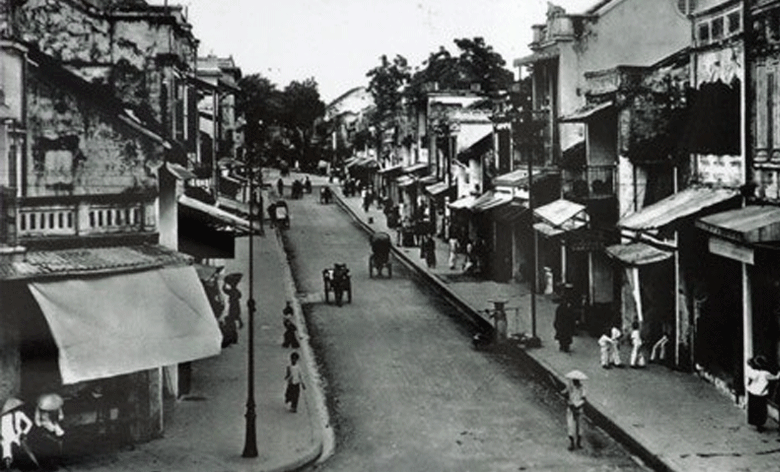
Although the old section of Hanoi is often called the "36 Old Streets," there are more than 36 actual streets. Some researchers believe that the number 36 came from the 15th century when there might have been 36 guild locations, which were workshop areas, not streets. When streets were later developed, the guild names were applied to the streets. Others attribute the 36 to a more abstract concept. The number nine in Asia represents the concept of "plenty." Nine times the four directions makes 36, which simply means "many." There are now more than 70 streets in the area.
Some streets have achieved fame by their inclusion in popular guidebooks. Han Gai Street offers silk clothing ready-made and tailored, embroidery, and silver products. Hang Quat, the street that formerly sold silk and feather fans, now stuns the visitor by its brilliantly colored funeral and festival flags and religious objects and clothing. To Thinh Street connects the above two and is still the wood turner's street. Hang Ma glimmers with shiny paper products, such as gift wrappings, wedding decorations and miniature paper objects to burn for the dead. Lan Ong Street is a sensual delight of textures and smells emanating from the sacks of herbal medicinal products: leaves, roots, barks, and powders.
The most famous streets of Hanoi Old Quarter
Hang Tre Street
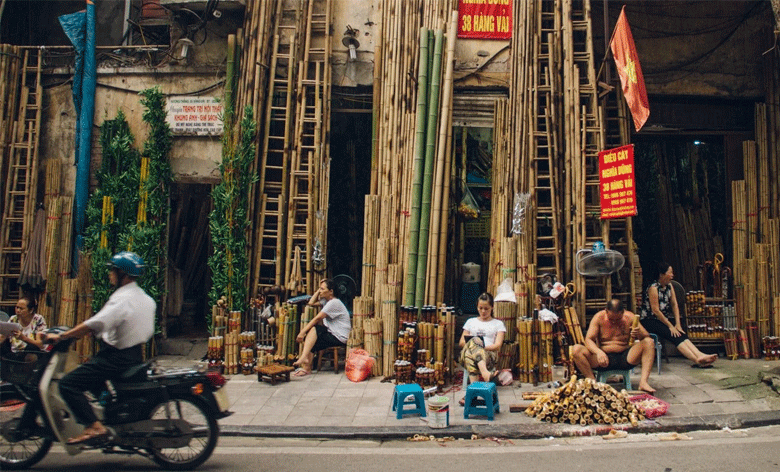
In the mid-19th century, the guild of bamboo raft makers was located on this street outside the My Loc gate, one of the many sturdy gates to the city. The cai mang raft consisted of 12 to 15 large bamboo poles lashed together by strips of green bamboo bark. Their anterior was slightly raised by heating the wood, and the aft was rigged with three quadrangular sails made of coarse linen dyed with extracts of sweet potato skins.
Bamboo rafts were sensible for Hanoi's shallow rivers, lakes and swamps, which can not provide solid anchorage or natural shelter from storms. The flat design better weathered the seasonal typhoons that lash the northern part of Vietnam, and is better adapted to coastal and river fishing. The bamboo poles from which the rafts were constructed were sold one block east on Hang Tre Street.
Distance from our hotel: 300 m - 2 min walk
Cau Go Street

Meaning "Wooden Bridge," Cau Go Street is located one block north of the Lake of the Restored Sword, and was in fact the location of a wooden bridge. About 150 years ago, the bridge crossed a thin stream of water connecting the Thai Cuc Lake with the Lake of the Restored Sword. Dyers from the neighboring Silk Street set out their silk to dry or bleached their fabric beside the bridge. Under the French occupation, the lake and stream were filled as health measures and to increase buildable land. The little wooden bridge became a regular street.
On the edge of the lake, women in wide brimmed hats once sold armfuls of flowers to the French for a few coins. Today a flower market exists where the Cau Go alley intersects with the main street. Other historical sites on Cau Go are the secret headquarters and hiding place of the 1930-45 "Love the Country" resistance movement.
Cau Go today is a commercial street specializing in women's accessories.
Distance from our hotel: 600 m - 3 min walk
Hang Dao Street
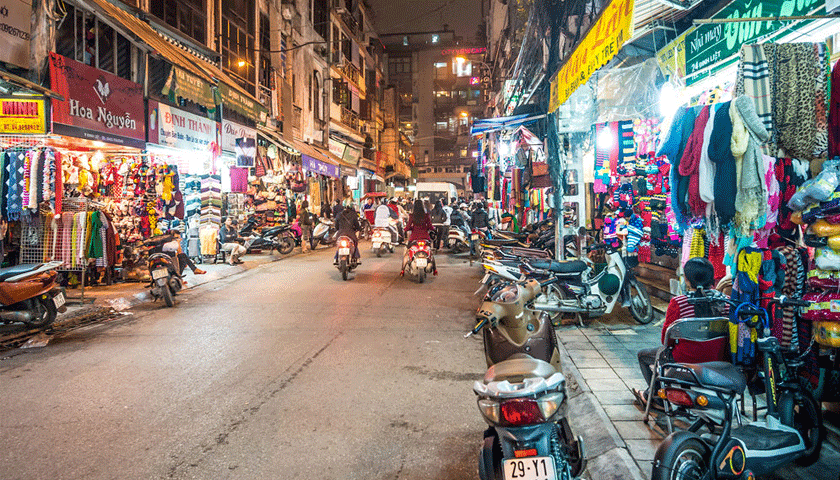
This street is one of Vietnam's oldest streets. It serves as a main axis running from north to south, cutting the Old Quarter in half. In the French Colonial time, Hang Dao Street was a center for the trading of silk products. On the first and sixth days of the lunar month, there were fairs for the sale of silk items. Shops also sold other types of fabric such as gauze, brocade, crepe, and muslin. Almost all the non-silk products were white.
In the beginning of the 15th century, this street was the location of the silk dyer guild from the Hai Hung Province, which specialized in a deep pink dye. Dao, the name of the street, refers to the pink of apricot blossoms, which are symbolic of the Vietnamese Lunar New Year. The demand for this special color was so high that the fabric had to be dyed at other locations as well.
By the 18th century, the dye colors diversified. In the 18th-century work Notes About the Capital, the author wrote that "Hang Dao guild does dying work. It dyes red as the color of blood, black as Chinese ink, and other beautiful colors."
In the 19th century, Hang Dao was lined by about 100 houses, of which only 10 or so were constructed of bricks. The rest were of thatch. On the side of the street alongside the now filled-in Hang Dao Lake, the foundations of the houses have visibly sunk lower than the road.
By the turn of this century, Indian textile merchants opened shops for trading silk and wool products imported from the West. This street now specializes in ready-made clothing.
Distance from our hotel: 700 m - 9 min walk
Dong Xuan Street / Market Street
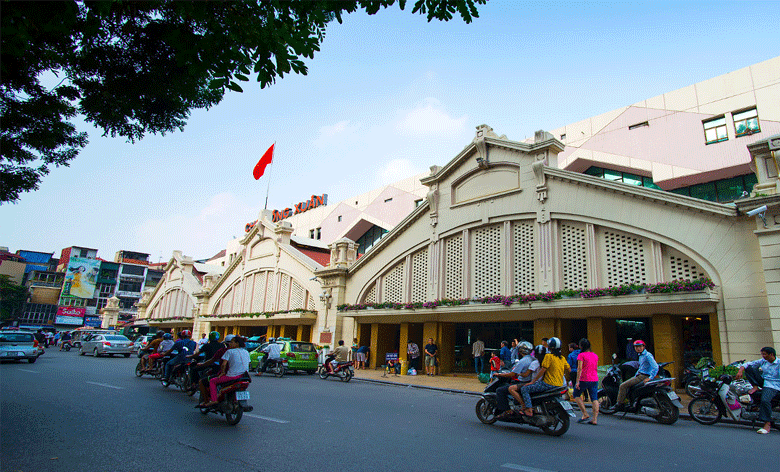
This street originally belonged to two villages-the even numbered houses were occupied by the Nhiem Trung village, and the odd numbered houses were occupied by the Hau Tuc village.
The Dong Xuan market, Vietnam's oldest and largest market, occupies half of the street.
River networks formed the economic hub of Hanoi by providing a system of waterways which fed the city and markets. Located at the confluence of the To Lich and Red Rivers, the Dong Xuan market was once one of the busiest urban areas in Southeast Asia.
The French required merchants to bring their goods inside the fenced perimeter of the market in order to facilitate tax collections. When the number of merchants swelled, the market was enlarged. In 1889, a structure was built over it, and five gates were built leading to it. Each of the five market gates was used only for specified goods. In 1992, the market was renovated and a new facade erected.
Distance from our hotel: 1.1 km - 13 min walk - 4 min by car
Hang Mam Street
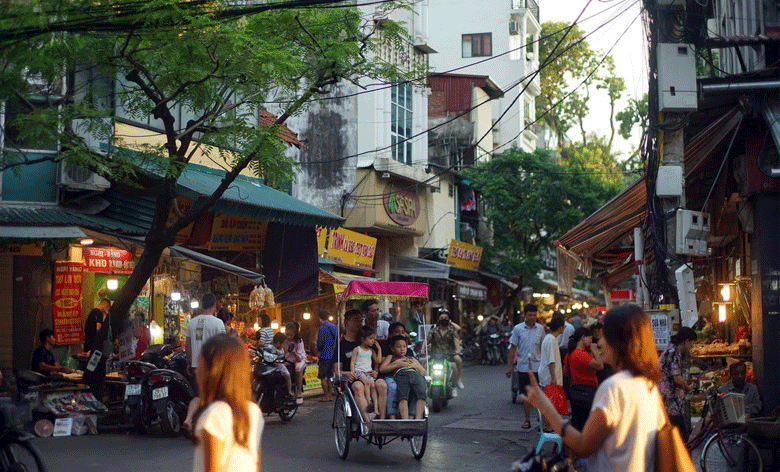
Hang Mam is the union of two old streets: an eastern offshoot called Hang Trung and the original Hang Mam. The name is derived from the various kinds of mam, or fish sauces, that are produced and sold here, as well as other sea products. The street was originally on the riverside, close to the day's catch.
Nuoc mam, or fish sauce, is made from fish that are too small to be sold individually which are placed in clay vats with water and salt. Boiled water is poured over the fish and weights are placed on top of the mixture to compress it. The concoction distills for days, and the result is a clear amber juice that is rich in protein, vitamins and minerals. With aging, the fierce ammoniac odors of the fish become mellow, and like brandy, the flavor improves. The first pressing, which is the clearest and purest, is called nuoc mam nhi, or prime. The sauce was stored in barrels made on adjacent Hang Thung Street.
In the 1940s, new specialties appeared on the street. A small ceramics industry appeared along with those of memorial stone etching, coffin, and tombstone manufacturers
Distance from our hotel: 350 m - 2 min walk
Ma May Street
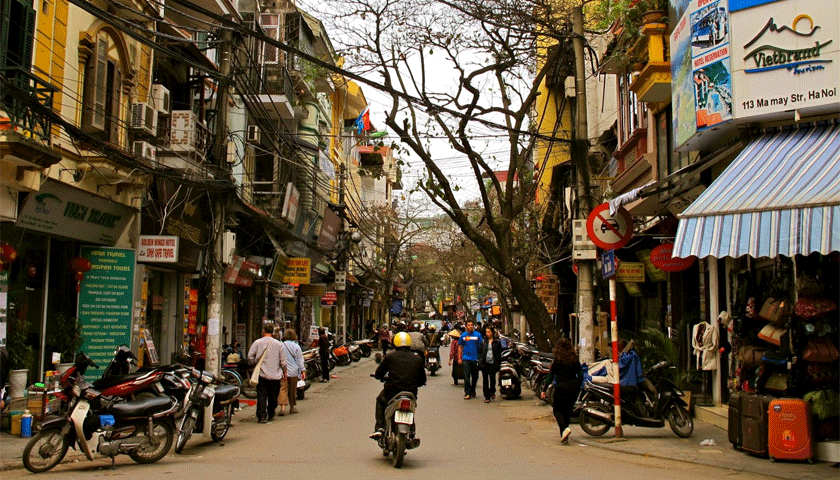
This street also is a union of two old streets. Hang May sold rattan products, and Hang Ma sold sacred joss (paper replicas of money, clothing, even stereo sets) to burn for the dead. Ma is burned in front of the altar of ancestors accompanied by prayers. Around the turn of the century, the streets became one: Ma May.
In the French time, this street was called "Black Flag Street" because the soldier Luu Vinh Phuc had his headquarters here. Luu was the leader of the Black Flags, a bandit unit operating around Hanoi in the late 19th century. They were essentially pirates who made a living robbing villagers and merchants. In the 1880s, the Black Flags cooperated with the Vietnamese Imperial Forces to resist the French who were attempting to gain military control of Hanoi.
In the middle of the street is the Huong Tuong temple, established in 1450, which honors Nguyen Trung Ngan (1289-1370), a governor of Thang Long, the former name of Hanoi.
Distance from our hotel: 450 m - 6 min walk
Hang Thiec Street
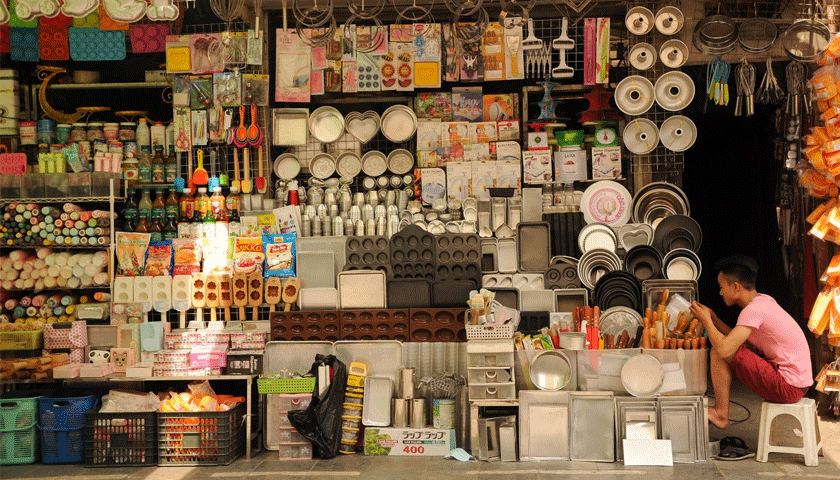
Hang Thiec is the street of tinsmiths. The craftsmen originally produced small tin cone-shaped tips which were used to preserve the shape of the traditional conical hats. A neighboring street, Hang Non, made the hats, and both streets comprised the Yen No hamlet.
Hang Thiec Street also produced oil lamps, candle sticks, and opium boxes. Tin shops sold mirrors, which they still do today, along with sheet metal, zinc, and glass. The street echoes busily with the clanging of hammers against the sheet metal. Workers spread out on the sidewalk shaping metal storage boxes and other objects to custom order.
Distance from our hotel: 850 m - 11 min walk
Hang Thung Street

In the old days, on this block inside the Dong Yen gate, barrels were manufactured. The barrels were used for storing and carrying water and fish sauce. The communal house and the temple of the barrel makers' guild is located at 22 Hang Thung, but is hidden behind newer buildings. The street is shaded by the leaves of the xoan tree which has a fluffy cream colored cluster flower and bright red berries. The tree has various English names: Margosa, Bead, or China Berry tree. In May, the tiny flowers fall to the ground like yellow confetti. The furrowed bark is often scraped off by local residents, who dry and boil it to make a medicinal infusion as a vermifuge.
The Old Quarter is a precious legacy of Hanoi's ancient past, but the area is challenged by rapid changes.
Today, handicraft production is increasingly replaced by restaurants, repair shops, and mini hotels. Historic buildings have become mass living spaces and schools as the population increases. Craft workers now constitute nine percent of the neighborhood. Traders make up 40 percent.
With the new economic policies, a dramatic building boom has begun, threatening the charm of the district. Local, national, and international agencies are now formulating plans to preserve the historic ambiance of the Old Quarter.
Distance from our hotel: 190 m - 2 min walk


 en
en TIẾNG VIỆT
TIẾNG VIỆT